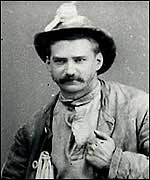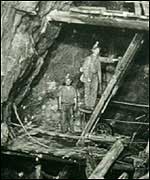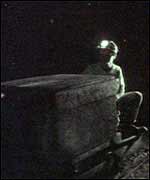|
From prehistoric
times Cornwall's rich supply of tin and copper attracted many prospectors
and workers to the region.
Early man
would barter pottery, salt, and cloth in return for tin and lead from
Cornwall. This signified the beginning of a long and turbulent history
of tin mining in the South West.
Humble
beginnings
 |
|
Early
tin miner with tallow candles around his neck |
From the
early settlers who arrived in Cornwall from Europe around 2300 BC, to
the later half of the 17th Century, Cornish mining was largely limited
to surface mining.
Developments
towards the end of the 17th Century saw the introduction of gunpowder
in the process of mining.
Controlled explosions helped in breaking up the rock and further increased
mining prosperity.
But shallow mining was to soon be replaced by deep rock mining underground.
Rich
Pickings
But it wasn't
until the 18th Century and the invention of machine driven pumps, that
Cornish tin mining became a capitalist concern.
Mine
shafts inevitably dropped below water level, so prior to this date, shallow
mining was the only way to extract the tin and copper from the ground.
The machine
driven pump was powered by steam engine and was capable of lifting several
gallons of water per minute from great depths.
In 1710,
the first steam driven water pump was installed in Cornwall, allowing
deep mining to take place for the first time.
These pumps
were so successful that the output of tin and copper rose prodigiously
and Cornwall became the home of deep mining.
On the
up
 |
|
Conditions
below ground were often dangerous |
The introduction
of the steam driven pump was a turning point for Cornish mining.
By 1801 there were 75 mines employing around 16,000 people in Cornwall.
In 1819
the two major mining groups Great Consolidated and United were created.
John Taylor, one of Cornwall's greatest mining engineers, managed both
groups which together produced thousands of tons ore.
The mined
ore was sent down the Redruth and Chasewater railway for shipping around
the world at Devoran and Restronguent Creek.
From boom to bust
Cornish
tin mining reached its zenith in the 19th Century.
 |
|
A
bleak future for tin |
By 1862
Consols and United had merged to form Clifford Amalgamated mines and there
were around 346 mines in Cornwall, with a working population of 50,000.
Despite
the collapse of the copper mining industry in 1866, the tin industry was
still riding high producing 10,000 tonnes of tin a year - about half the
world's production.
But such
success was short lived.
During the 20th century tin mining was characterised by cycles of boom
and bust.
There is
a saying, what goes up, must come down, and in a few short years Cornish
tin mining - like its mines - was about to learn just how far down it
could go.
Timeline
1700BC-1400BC
- Earliest Cornish tin mines
1919 - Levant
Mine Disaster
1985 - Tin
prices plummet on the Tin Exchange
1986 - Closure
of Geevor Mine in Cornwall
1998 - South
Crofty is the last Cornish tin mine to close
|

